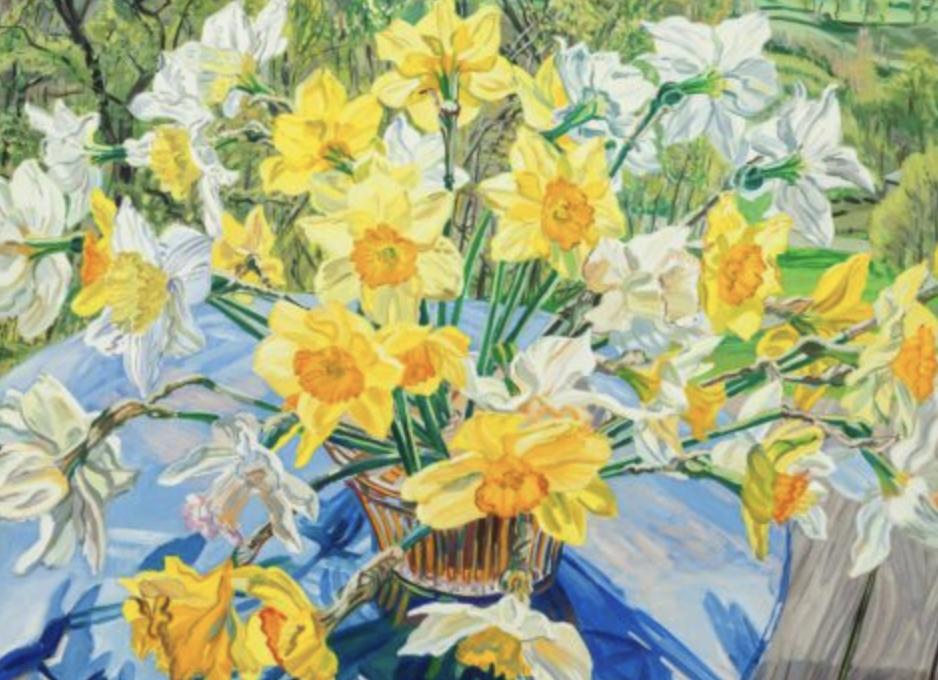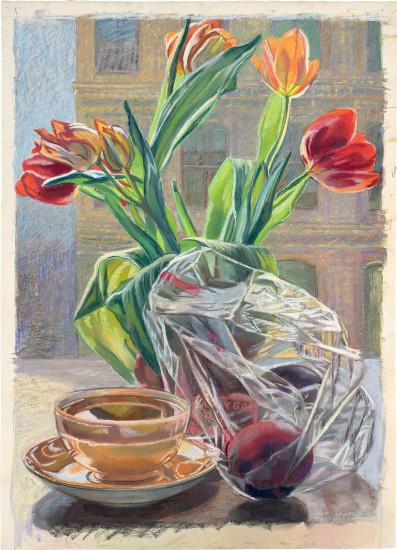Janet Fish, an American artist born in Boston in 1938, was raised in Bermuda from the age of ten. Her grandfather, the American Impressionist Clark Voorhees lived and had his studio there. Her mother was a sculptor and potter, her uncle a wood carver, and her aunt a painter. Fish says, “I came from a family of artists, and I always made art and knew I wanted to be an artist.” She graduated from Smith College and attended the Art Students League during summer breaks. In the summer of 1962, while studying at the Skowhegan Summer School, Fish decided to paint landscapes and still lives.
Fish completed a Masters of Fine Arts degree (1963) at Yale University School of Art and Architecture. She planned to teach at a college, but she was advised to try to teach at a girl’s school instead, because she was a woman. She moved to Philadelphia and then to Soho in New York City, where she took odd jobs to support herself. The New York art world was transitioning from Abstract Expressionism to Pop, Op, Minimalism, and Conceptual Art. Her decision to paint landscapes and still lives went against the trend. Nevertheless, Fish was offered a show in 1971 by Jill Kornblee at her gallery. Despite the odds against her, Fish was a success from that point on, and she became part of the vibrant New York art scene.
“Tulips and Coffee Cups’’ (1982) (36’’x 26’’) (pastel) is an early example of Fish’s work. Fish depicts a vase of tulips, a grocery store plastic bag with fruit, and a Carnival glass coffee cup with a New York building as the background. Fascinated by sunlight on reflective surfaces, she began painting packages of plastic wrapped fruit, and glasses filled with liquid. Raised in the sunlight of Bermuda and having studied Josef Albers color theory in college, she was inspired and influenced by both. She became a master at organizing interesting and intricate compositions. New York City street markets and antique shops became a constant source of shiny objects. She says, “I see light as energy, and energy is always moving through us. I don’t see things as being separated—I don’t paint the objects I paint one after the other. I paint through the painting.”
The first day of Spring arrived on March 20, 2022, and with Spring comes the emergence of life from the cold Winter earth. This writer has chosen Janet Fish for her masterful art, but also to celebrate Spring with works that welcome the season. Tulips are a welcome sight in gardens, and they have brought pleasure to the world for centuries. They are symbolic of perfect love, charity, and a new season. Each color of tulip has its own special meaning. Yellow tulips make people feel happy and lift spirits and bring hope. The Victorians, who attributed specific meanings to everything, said yellow tulips meant “there’s sunshine in your smile.” Red tulips symbolize passion and eternal love.
Fish added various elements to her paintings as her art developed. Distant landscapes began to appear, for example, in “Daffodils and Spring Tree” (1988) (60’’x 48”) (oil). Lush green hills and valleys create an intense contrast to the bouquet of daffodils that occupies the lower half of the painting. The daffodils sit in an orange glass vase created by the use of vertical splashes of color. The orange color of the vase is the complement to the blue color of the large glass plate under it. The plate reflects the stems of the flowers to create an interesting and active triangular pattern of diagonals. The wooden slats of a table are placed on the diagonal to lead the eye of the viewer into the landscape. The brown slats are a mixture of complementary colors, blue and orange, red and green, and yellow and purple, all of which combine to create brown.
Daffodils (genus flora Narcissus) are the first perennials to bloom at the end of March. They even come out in a March snow. Like spots of sunlight on the ground, they also symbolize Spring, new beginnings and rebirth. They have lived through the cold of Winter and now return to bring joy. Fish does not copy nature like a photographer or paint nature in the style of the Photorealist or New Realism painters. She thinks and composes like a painter, combining elements to create something beyond a photographic representation: “I would like it to be more of a novel than a short story, so you could go back in and see something different another time.”
The discussion of women’s rights and feminism by Betty Friedan, Gloria Steinem, and others, began in the 1960’s and 1970’s. The first exhibition of work solely by women artists was held in San Francisco in 1976. Janet Fish was the first woman to receive a Master’s of Fine Arts degree from Yale (1963) and being told she should not, (could not) teach in a college because she was a woman, Fish was very aware of prejudices against women artists. There were a very few women who taught in art departments in colleges, and even fewer had their work shown in museums and exhibitions. Fish went on to teach art at the School of Visual Arts and Parsons (The New School for Design) in New York City. She also taught at Syracuse University and the University of Chicago. Janet Fish lives in New York City and in Middletown Springs, Vermont, where she has a garden that continues to inspire her.
Beverly Hall Smith was a professor of art history for 40 years. Since retiring with her husband Kurt to Chestertown six years ago, she has taught art history classes at WC-ALL and Chesapeake College’s Institute for Adult Learning. She is also an artist whose work is sometimes in exhibitions at Chestertown RiverArts and she paints sets for the Garfield Center for the Arts.




I remember being a freshman art student at Smith and glimpsing an upperclassman at an easel using an astonishing combination of colors. I don’t recall the subject matter but the blues, violets and pinks were so beautifully interwoven that it took my breath away. Years later I realized Janet Fish was the painter. Thanks for fleshing out her bio; didn’t realize that even she experienced discrimination early in her career.